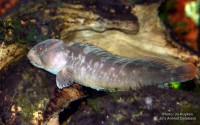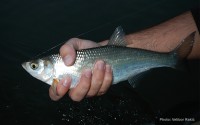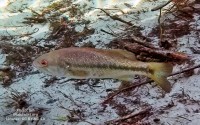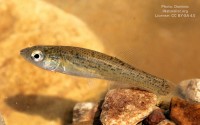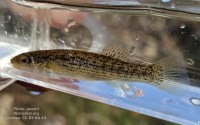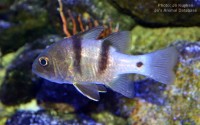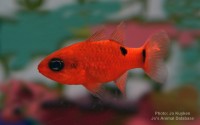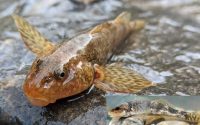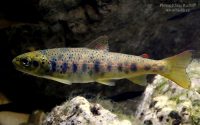Spotted archerfish
(Toxotes chatareus)
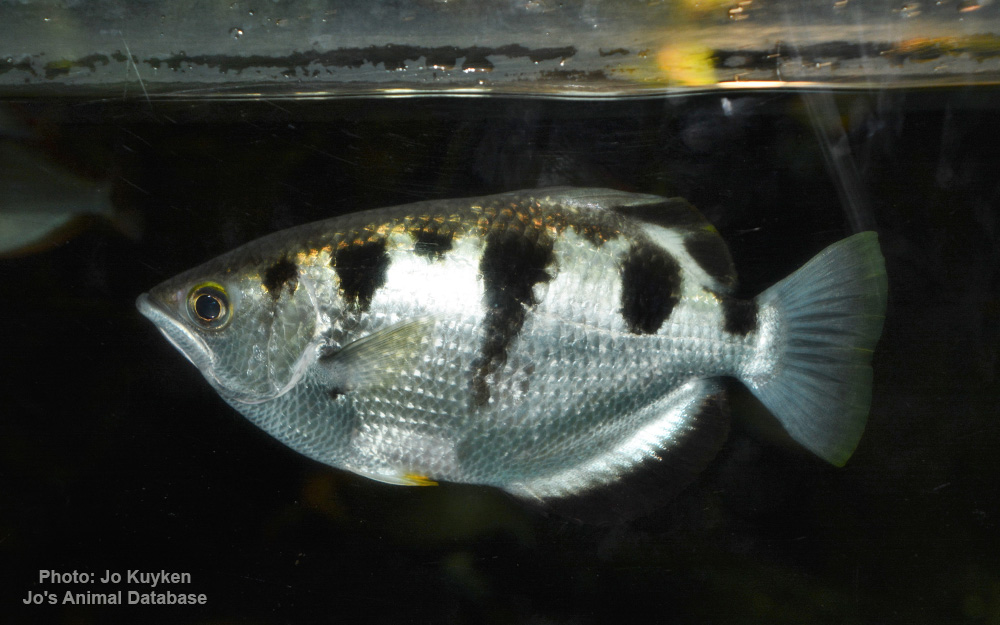
Image source: Jo's Animal Database
Classification
General data
Toxotes chatareus, sometimes known by the common names common archerfish, seven-spot archerfish or largescale archerfish, is a species of perciform fish in the archerfish genus Toxotes.
They are usually no larger than 20 centimetres (7.9 in) but may grow up to 40 centimetres (16 in).
Unlike most archerfish, T. chatareus are sooty rather than silvery in colour.
They are omnivorous, feeding on insects, fish, and vegetative matter at the surface of the water. Breeding occurs in the wet season, and 20,000 to 150,000 eggs may be laid at one time.
T. chatareus are distributed throughout southeast Asia and the Indo-Pacific and Australia. They may live in brackish or fresh water, inhabiting mangrove swamps and estuaries as well as further upstream in slow-moving rivers. While occasionally caught and eaten,
T. chatareus have five or six dorsal spines, the fourth of which is the longest, and twelve or thirteen dorsal soft rays. The dorsal spines are generally shorter in specimens collected from freshwater than those from brackish water. T. chatareus also have three anal spines and fifteen to seventeen anal soft rays. T. chatareus have 33 or 34 lateral line scales. The caudal (tail) fin in almost square. The anal fin is undivided and the third anal spine is longest.
Overall, the body is sooty[9] but sometimes silvery or gold.[7] The dorsal side is \\\"greenish brown\\\".[7] The pectoral fins are clear or \\\"dusky\\\" in colour.[6] Pelvic fins may be darker and heavily pigmented.[6] T. chatareus are white and usually has six or seven dark blotches, alternating long and short, along the dorsal side.[9] A dark blotch is also found at the base of the caudal fin. The colour of these blotches may become darker or lighter due to time of day, environment, and stress.[6] The blotches of young fish are darker than those of older fish.[7] Startled or stressed fish are darker than unstressed fish; fish found in cloudy water may be completely white.[6] It is unknown whether sexual dimorphism occurs.[10]
Comparison to other archerfish
T. chatareus can be distinguished by their sooty colour, as opposed to the typical silver of most other archerfish.[9] They have five dorsal spines, whereas T. jaculatrix have four. The markings on their flanks are also alternating long and short spots rather than bands.[9] T. chatareus also have six or seven markings on its sides, whilst banded archerfish have four to five.[9] T. chatareus has 29–30 lateral line scales, compared to 33–35 in T. jaculatrix.[10] T. chatareus are also less common upstream than T. microlepis.[4]
Toxotes chatareus are found in India, Burma, Indonesia and New Guinea, and northern Australia.[6][5] They are generally found in temperature ranges of 25 to 30 °C (77 to 86 °F),[5] though they have been recorded at temperatures as high as 36 °C (97 °F) in the Alligator Rivers region and as low as 20.5 °C (68.9 °F) in the Burdekin river region; these are believed to be the upper and lower limits of their tolerance, respectively.[6] Brackish mangrove swamps form its main habitat, but T. chatareus are also found in freshwater rivers and streams.[5] It occurs in rivers of the Kimberley region of Western Australia, the Kakadu area of the Northern Territory and Arnhem Land in Australia.[6] On the Mekong river, it may be found as far north as Thailand and Laos.[4] They are also found in the upper parts of the Burdekin river, somehow having overcome the Burdekin Falls.[6] T. chatareus are distributed more \\\"patchily\\\" in eastern Australia, and are less abundant.[6]
T. chatareus are known to occur in shaded areas with vegetation overhead, usually at the top layer of the water column. They are found only where there is an intact riparian area, as this is a major source of their food.[6] T. chatareus are usually not found in fast-flowing streams.[6]

